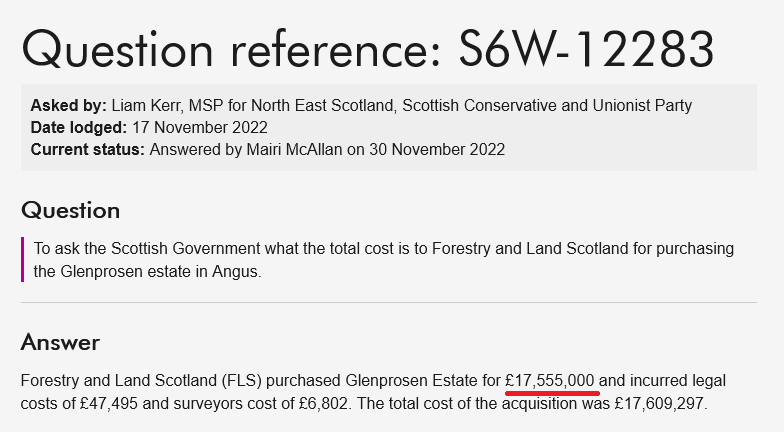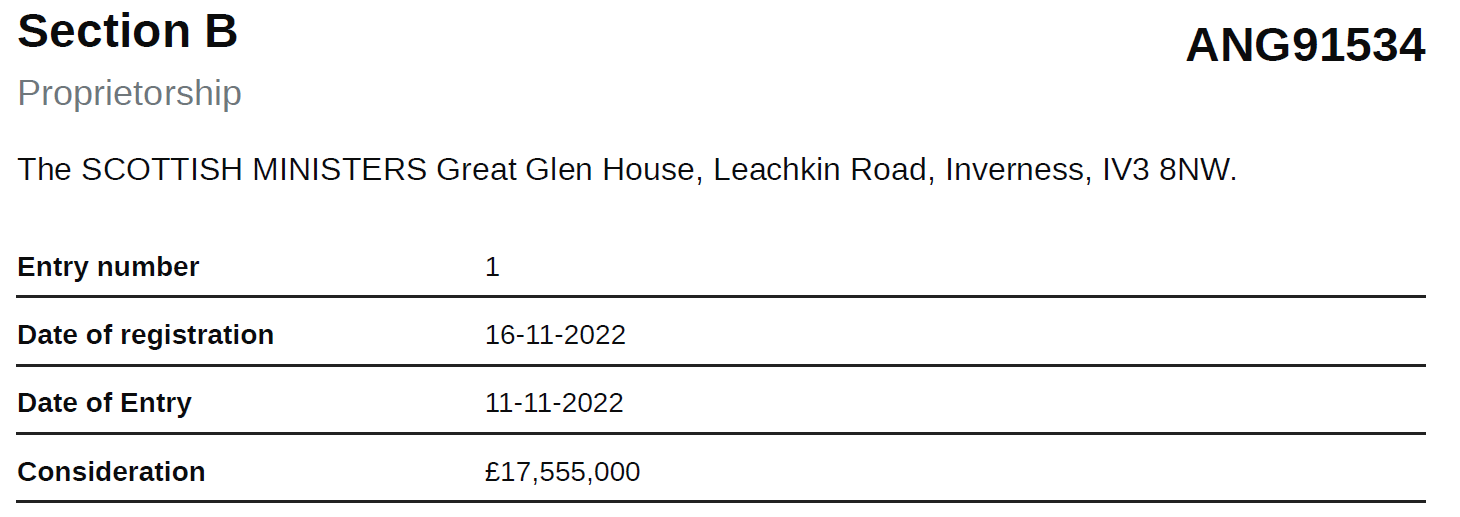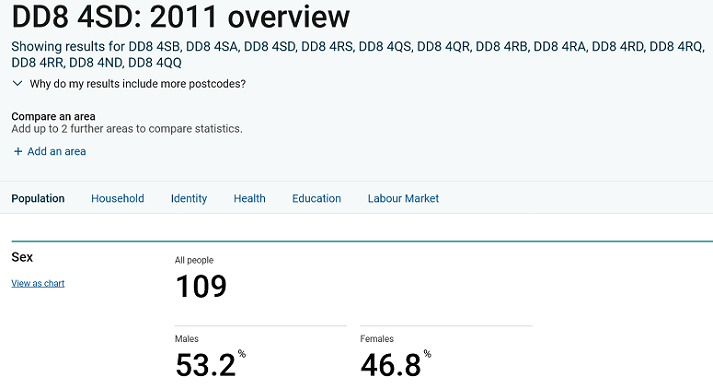This post provides an update to what I wrote in October on Forest and Land Scotland’s purchase of the Glen Prosen estate (see here). So far, Forest and Land Scotland has issued not a single news release about their purchase or their plans. Nor does it appear to have published any other information which would enable the public to know what is going on. This post therefore is based on information published on the Land Registry and responses to a number of questions in the Scottish Parliament from the Minister responsible, Mairi McAllan.
In the absence of other information, Tory MSP Liam Kerr – rightly in my view – submitted a number questions about the purchase to the Scottish Parliament. These were followed last week by what appears to have been a “planted” question from local MSP Graeme Dey which enabled the Minister to make some statements about the purchase and the Scottish Government’s intentions (see here).
Mairi McAllan’s response to Graeme Dey and Liam Ker raises more questions than it answers, both about the how the land in Glen Prosen will be managed and about the Scottish Government’s approach to land reform.
Unfortunately, the purchase has also turned into a party political spat between the SNP and the Tories which risks obfuscating the issues, as this statement illustrates:
Mairi McAllan
“As Liam Kerr has taken the opportunity to state on the record what the actual sale price was, I hope that he and his colleagues will consider some of the more spurious figures that they have used in the chamber before, which I was unable to correct owing to confidentiality. I will leave it to them to consider their responsibilities for correcting the record.”
Liam Kerr got the figure wrong, he stated it was £18m, and Mairi McAllan then repeated the mistake, bizarrely because she had already provided Mr Kerr with the correct figure at the end of November!

This answer also shows that Mairi McAllan’s claim that she was unable to correct the “spurious figures” was highly misleading. With the Land Registry having registered the sale on 16th November, there was no reason – whatever confidentiality clauses were agreed with the seller – why FLS or the Scottish Government could not have put the record right on that date. The real question here is why they appear to be so reluctant to make this information widely available.
The implication of the purchase for land prices
The “spurious figures” came from media reports at the end of October which suggested that FLS had bought 16,500 acres for a rumoured £25m. With the Land Registry showing the size of the Glen Prosen to be 3453 hectares or 8,532 acres it was difficult to make sense of that as I explained in my last post.

Besides the purchase price, the information now on the Registers of Scotland records the estate as being slightly smaller, 3437.1 hectares or 8493.259 acres in size, perhaps as a result of the previous estate owners retaining a house and grounds. With the sellers having bought the land for £4,012,000 in 2011 they have still almost quadrupled their money in 11 years and the Scottish Government has paid £2066 an acre.
Mairi McAllan’s parliamentary response explaining the purchase indicates that the Scottish Government sees FLS as a player in the land market like everyone else:
“FLS operates in a competitive commercial land market, where its job is to work to optimise benefits for the people of Scotland. It was one of a small number of potentially interested parties that were approached by the agents to bid. Given the enormous strategic opportunity that the former sporting estate presented for Scottish Government objectives, FLS opted to offer”.
There is no consideration here about why the Scottish Government should be enabling private sporting estates to make obscene profits, particularly when as I showed in the last post how much of the land in Glen Prosen is trashed. Nor is there any awareness that by fuelling land prices the Scottish Government is putting land beyond the reach of local communities. This is from the Scottish Minister who also leads on Land Reform.
What consultation took place about the purchase?

This answer is also shocking but sadly par for the course for FLS. It repeats what happened when the then Forestry Commission Scotland secretly bought part of Rothiemurchus Forest on Speyside for £7.2m in 2016 (see here) without consulting the Cairngorms National Park Authority (CNPA) or NatureScot, the agency responsible for protection the Caledonian Forest there. NatureScot is also involved in Glen Prosen since parts of the estate fell came under the Section 7 agreement designed to reduce deer numbers at Caenlochan.
FLS’ failure to consult the CNPA and NatureScot happened during the same time period the Scottish Government was consulting on whether new land reform legislation should require all sales of land over 3000 hectares to be subject to a public interest test. Whatever their failings, who better to assess that public interest in the National Park than the CNPA and NatureScot?
As I have argued previously on parkswatch, all sales of land which could impact on our National Park’s four statutory objectives should be subject to a public interest test by our National Park Authorities. That would not have precluded FLS buying the Glen Prosen Estate but it would have ensured it was doing so for the right reasons. The CNPA should have been involved but has instead been undermined by another arm of government.
The reasons for the purchase?
FLS has never stated why it bought Glen Prosen or how it intends to use the land. This is what Mairi McAllan told the Scottish Parliament last week:
“The Glenprosen estate will be managed by Forestry and Land Scotland in accordance with a variety of Scottish Government policy aims to benefit people, nature, the climate and the local economy”.
And,
“I have already rehearsed some of the multiple benefits that will come from the purchase. Landscape-scale woodland creation is an opportunity, as are peatland restoration and community involvement.”
That could mean just about anything but does little to explain what the Scottish Government’s intention was in purchasing the land.
Is Glen Prosen to be a giant experiment designed to deliver the Scottish Government’s nature and climate objectives as proposed in NatureScot’s consultation on new National Parks (see here)? If so, why not say so? And if that is the case, would it not be better to give the land to the CNPA to manage?
Or is the primary reason for the purchase – as suggested by FLS’ involvement and the Minister saying “Landscape-scale woodland creation is an opportunity – to help the Scottish Government meet its tree planting objectives? If so, how will that fit with the CNPA’s National Park Partnership Plan which set a target of 35,000 ha of new woodland cover by 2045, 80% of which should be native woodland with at least 10,000 ha achieved by natural regeneration, not planting. (Sadly this target was watered down from the original plan which stated the majority of native woodland creation would be by natural regeneration).
It is somewhat worrying that in announcing the Scottish Government’s policy objectives Mairi McAllan made no reference to the CNPA’s targets, particularly when the main focus of FLS is on planting and harvesting sitka plantations on an industrial scale. It appears the public may have to wait a year until FLS has produced a draft Land Management Plan before there is any clarity about what the land on the Glen Prosen estate will be used for.
Future consultation and community involvement
Mairi McAllan
“By collaborating with the community and neighbouring public and private landowners and managers, FLS and the wider Scottish Government are keen to lead a partnership approach to land management and habitat restoration on a landscape scale across the Angus glens and in the Cairngorms national park.”
“I am glad to assure Mr Dey that FLS will actively engage with all stakeholders, including, in particular, as I said, the local community and neighbouring landowners”
Fine sounding words but why should the public believe any of this after Forest and Land Scotland’s failure to engage with the local community in Glenmore, represented by the Aviemore and Glenmore Community Trust, before deciding to outsource the management of the Glenmore campsite (see here)?
Politicians love to talk about engaging local communities but who is the local community in Glen Prosen? After the botched census, Scotland still does not have up to date population statistics, but the 2011 census records a total of 109 people people living in the Glen Prosen and Glen Clova areas:

Is that the target group for consultation? If so, a significant proportion of this small number of people will either be landowners or people tied to landowners, like the two former Glen Prosen estate staff granted tenancies by FLS. The commitment therefore appears to be to consult with landowners and then again with landowning interests as members of the local community!
Those landowning interests in the Angus Glens are at the centre of intensive grouse moor management in the Cairngorms National Park with its destructive consequences for the natural environment. Just 10 days ago Raptor Persecution Scotland reported yet another bird of prey unlawfully killed in the Angus Glens, this time in a trap (see here). Instead of tackling these interests, through banning driven up grouse shooting, the Scottish Government wants FLS to work in partnership with them. The results are quite predictable, FLS will get bogged down in endless negotiations making change very difficult if not impossible.
What the Scottish Government should ask FLS to do NOW at Glen Prosen
Formulating plans may take time, but it also requires transparency, and with the climate and nature emergencies our public authorities need to be taking immediate action where possible. FLS could deliver the following within the next month if they had the will:
- Issue information publicly about what has been bought (e.g. the number of properties included in the land sale), any conditions which could impact on future land-management (e.g there appears to be what is a sporting enclave with rights of access) and the main liabilities (e.g. the damage caused by previous track construction) – all questions which I drew attention to in my post in October (see here).
- Clarify how many staff lost their jobs/houses as a result of the sale and what actions have been taken to redress this (the parliamentary exchange suggests one former member of staff has been offered part-time employment by FLS).
- Remove ALL wildlife traps from the estate (see here), if this has not been done already.
- Stop all muirburn with immediate effect
- End all sheep grazing outside fenced enclosures and commit to challenging neighbouring landowners who allow sheep to wander onto their land
- Commit to reducing deer numbers to a maximum of 2 per square kilometre, which we know is the level which allows natural regeneration to take off, within three years and create stalking jobs to deliver this.
- Commit to working publicly with the Cairngorms National Park Authority to ensure future management of the Glen Prosen estate delivers National Park objectives and is used to put pressure on neighbouring landowners to change how they manage their land.
Source link
